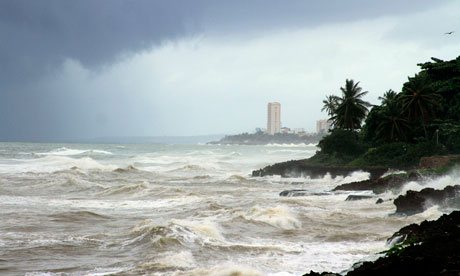Haiti's quake homeless wait as tropical storm approaches
More than 600,000 Haitians in makeshift camps face prospect of mudslides and flash floods when Emily makes landfall

Tropical storm Emily brings rough seas to Malecón, Dominican Republic. The storm is expected to bring heavy rain to Haiti. Photograph: Erika Santelices/AFP/Getty Images
Hundreds of thousands of Haitians still living in makeshift camps following last year's devastating earthquakes are braced for heavy rain and winds as tropical storm Emily approaches.
Forecasters predict the storm will make landfall on Haiti's southern peninsula, bringing the threat of mudslides and flash floods. More than 600,000 people still live without shelter after the earthquake in January 2010, which killed at least 46,000.
"If any storm comes, we meet our demise," said Renel Joseph, a 57-year-old resident of Cite Soleil, a seaside shantytown of Haiti's capital, Port-au-Prince.
David Preux, head of mission for the International Organisation for Migration in the southern city of Jacmel, said that he expected conditions to worsen during the night: "The problem is when people wait until the last minute to evacuate."
The storm's forward motion slowed on Wednesday night and it appeared likely to skirt the southern tip of the Dominican Republic, which shares the island of Hispaniola with Haiti. Emily had maximum sustained winds of 50mph (80kph).
Dominican authorities kept a tropical storm warning in effect for the south-western coast but ended an alert on Wednesday night from Cabo Francés Viejo south-eastwards to Cabo Engaño.
Although the centre of the storm seemed likely to miss most of the island, intense rain still posed a threat to both countries, said Diana Goeller, a meteorologist with the US National Hurricane Centre (NHC). The countries are divided by a range of high mountains.
"This storm has a lot of heavy rainfall with it," Goeller told the Associated Press. "So in those mountainous areas there could be very dangerous, life-threatening mudslides or flash floods."
John Cangialosi, a hurricane specialist with the NHC, said up to 20 inches (51cm) of rain was possible in high-elevation areas. That is enough to cause serious problems in a country prone to catastrophic flooding.
Michel Davison of the US National Oceanic and Atmospheric Administration said the storm earlier dropped up to 10 inches of rain in parts of Puerto Rico, though its centre never got within 100 milesof the island.
Francois Prophete, who was shoring up the corrugated-metal roof of his one-room cinder block home in the hills south-east of Port-au-Prince, said most people had few options in a nation where the vast majority are desperately poor. "We can't afford to do much," he said.
Local authorities urged people to conserve food and safeguard their belongings.
An unknown number of people left flood-prone areas to stay with relatives and friends, said Emmanuelle Schneider, a spokeswoman for the UN's Office for the Co-ordination of Humanitarian Affairs. There had been no government-organised evacuations by late on Wednesday, she added.
"There will be an official evacuation when there's flooding," Schneider said.
There was reason for concern. A slow-moving storm in June triggered mudslides and floods in Haiti and killed at least 28 people. And widespread poverty makes it difficult for people to take even the most basic precautions.
Joceline Alcide stashed her two childrens' birth certificates and school papers in little plastic bags that aid groups handed out. It was her only means to protect herself.
"There really isn't much more we can do. We just got these bags," the 39-year-old said, standing outside her tarpaulin shelter.
The Guardian
No comments:
Post a Comment